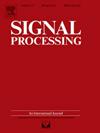Optimized sparse 2D antenna array design via beampattern matching
IF 3.4
2区 工程技术
Q2 ENGINEERING, ELECTRICAL & ELECTRONIC
引用次数: 0
Abstract
Emerging millimeter-wave (mmWave) MIMO radars combine the benefits of large bandwidth available at mmWave frequencies with the spatial diversity provided by MIMO architectures, significantly enhancing radar capabilities for automotive, surveillance, and imaging applications. However, deploying large numbers of antennas and transceivers at these high frequencies substantially increases chip complexity and hardware costs. In this paper, we address the design of sparse two-dimensional (2D) antenna arrays that retain the desirable beampattern characteristics of fully populated arrays – namely, narrow mainlobes and low sidelobes – while significantly reducing the required number of antenna elements. We formulate the sparse array design problem as a beampattern matching optimization, which selects optimal subsets of transmit and receive antenna positions from an initial dense grid. To efficiently solve this challenging nonconvex optimization problem, we introduce an iterative algorithm combining Majorization–Minimization (MM) and Alternating Optimization (AO) techniques. We provide theoretical guarantees for convergence to at least a local optimum. Additionally, we propose a weighting vector optimization step to further enhance sidelobe suppression. Numerical simulations confirm that the proposed method maintains angular resolution and Sidelobe Levels (SLLs) comparable to those of full arrays, while substantially reducing hardware complexity and cost. Performance comparisons against existing methods demonstrate notable improvements in sidelobe suppression and computational efficiency without compromising processing gain.
基于波束匹配的二维稀疏天线阵优化设计
新兴的毫米波(mmWave) MIMO雷达将毫米波频率的大带宽优势与MIMO架构提供的空间多样性相结合,显著增强了雷达在汽车、监视和成像应用中的能力。然而,在这些高频上部署大量的天线和收发器大大增加了芯片的复杂性和硬件成本。在本文中,我们讨论了稀疏二维(2D)天线阵列的设计,该天线阵列保留了完全填充阵列的理想波束特征-即窄主瓣和低副瓣-同时显着减少所需的天线单元数量。我们将稀疏阵列设计问题表述为波束模式匹配优化问题,从初始密集网格中选择最优的发射和接收天线位置子集。为了有效地解决这一具有挑战性的非凸优化问题,我们引入了一种结合最大化-最小化(MM)和交替优化(AO)技术的迭代算法。我们提供了收敛到至少一个局部最优的理论保证。此外,我们提出了一个加权向量优化步骤,以进一步增强副瓣抑制。数值模拟证实,该方法保持了与全阵列相当的角分辨率和旁瓣电平(SLLs),同时大大降低了硬件复杂性和成本。与现有方法的性能比较表明,在不影响处理增益的情况下,旁瓣抑制和计算效率显著提高。
本文章由计算机程序翻译,如有差异,请以英文原文为准。
求助全文
约1分钟内获得全文
求助全文
来源期刊

Signal Processing
工程技术-工程:电子与电气
CiteScore
9.20
自引率
9.10%
发文量
309
审稿时长
41 days
期刊介绍:
Signal Processing incorporates all aspects of the theory and practice of signal processing. It features original research work, tutorial and review articles, and accounts of practical developments. It is intended for a rapid dissemination of knowledge and experience to engineers and scientists working in the research, development or practical application of signal processing.
Subject areas covered by the journal include: Signal Theory; Stochastic Processes; Detection and Estimation; Spectral Analysis; Filtering; Signal Processing Systems; Software Developments; Image Processing; Pattern Recognition; Optical Signal Processing; Digital Signal Processing; Multi-dimensional Signal Processing; Communication Signal Processing; Biomedical Signal Processing; Geophysical and Astrophysical Signal Processing; Earth Resources Signal Processing; Acoustic and Vibration Signal Processing; Data Processing; Remote Sensing; Signal Processing Technology; Radar Signal Processing; Sonar Signal Processing; Industrial Applications; New Applications.
 求助内容:
求助内容: 应助结果提醒方式:
应助结果提醒方式:


